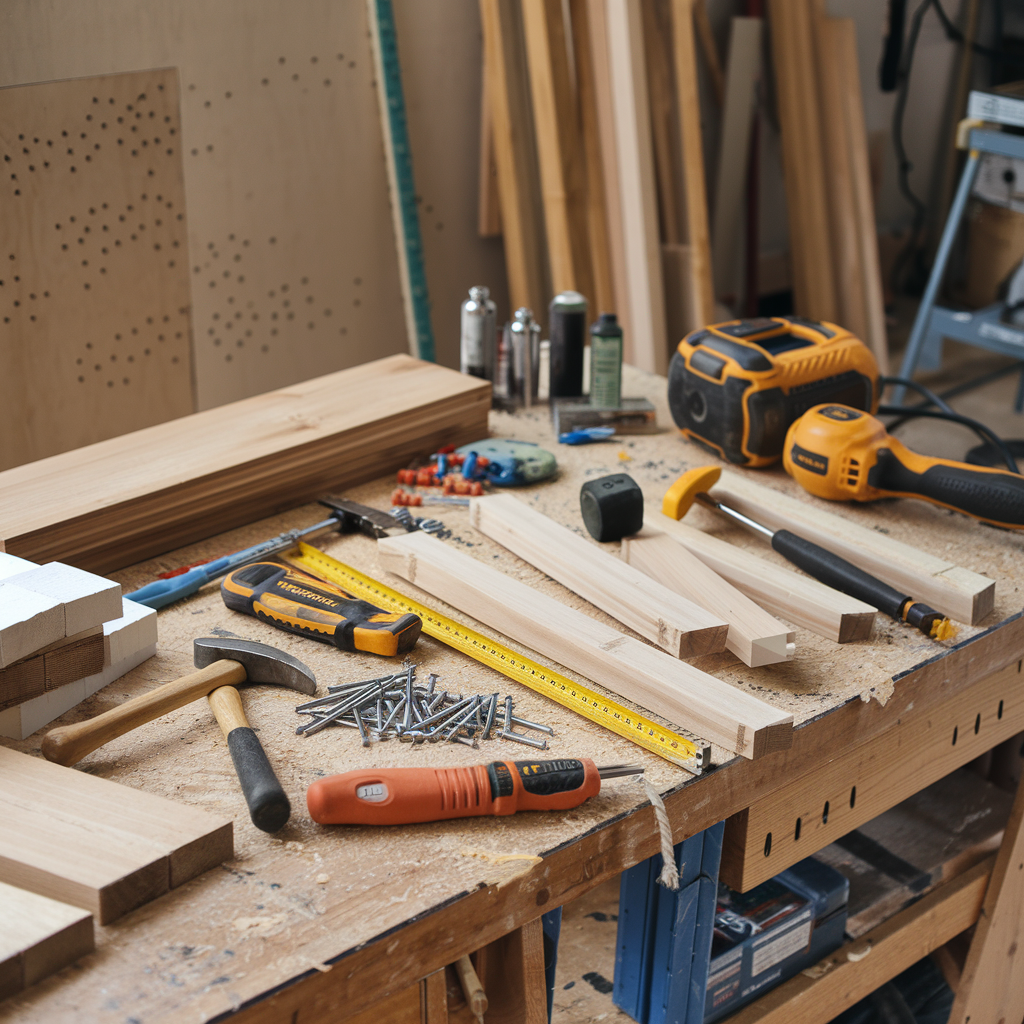Are you into DIY or just starting with home improvement? Having the right materials is key to a successful project. Imagine the joy of finishing a task with ease and a personal touch. That’s what a well-planned DIY project brings.
In this guide, we’ll cover the basics you need for your next project. We’ll talk about essential tools and supplies that bring your ideas to life.
Key Takeaways
- Importance of creating a comprehensive DIY project materials list
- How proper planning and organization of supplies can lead to successful home improvement and craft projects
- Overview of the different types of materials and tools covered in the article
- Emphasis on the role of a materials list in setting the tone for the entire DIY experience
- Inspiration for readers to embark on their next creative endeavor with confidence
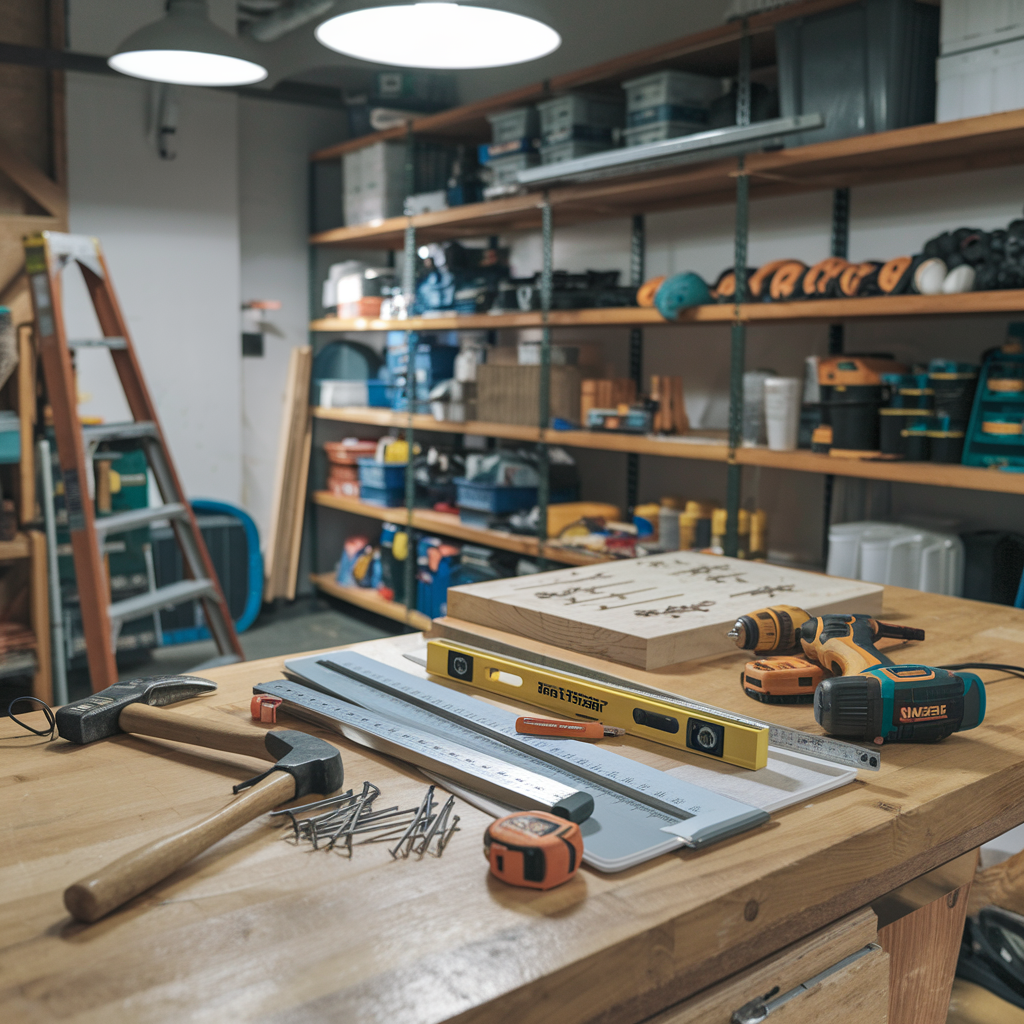
Essential Planning Tools for Your DIY Project
Before starting any DIY project, having the right tools is key. This includes project planning software, measuring tools, and budgeting aids. These tools help make your DIY project successful and stress-free. Let’s look at the essential tools every DIYer should have.
Project Planning Software and Apps
Staying organized is crucial for DIY projects. Luckily, many tools are available to help. Trello, Asana, and Monday.com are great for making task lists and setting deadlines. They also let you work with others easily.
These tools help you see your project timeline clearly. This way, you can avoid missing important steps.
Measuring and Marking Tools
- Tape measure: A reliable tape measure is a must-have for any DIY project, allowing you to precisely measure spaces, materials, and more.
- Ruler or straight edge: Whether you’re cutting wood, laying tile, or hanging shelves, a sturdy ruler or straight edge can help you make accurate markings and cuts.
- Laser level: For tasks that require precise leveling, a laser level can be an invaluable tool, ensuring your work is perfectly aligned.
Budget Planning Resources
Budgeting is vital for any DIY project. It helps you manage costs and avoid surprises. Online tools like Excel or Google Sheets can help you make cost estimates and track spending. Many hardware stores and home improvement websites also offer cost calculators.
| Tool | Description | Key Benefits |
|---|---|---|
| Project Planning Software | Digital platforms like Trello, Asana, and Monday.com for organizing tasks, deadlines, and collaboration | Improved project visibility, task management, and team coordination |
| Measuring Tools | Tape measures, rulers, and laser levels for precise sizing and marking | Accurate measurements and alignments for effective project execution |
| Budget Planning Resources | Digital spreadsheets and cost calculators for estimating and tracking project expenses | Effective cost management and avoidance of unexpected financial surprises |
Using these planning tools, DIYers can start their projects with confidence. They ensure they have the right resources, measurements, and budgets. With careful planning, the DIY journey can be rewarding and smooth.
Understanding Your DIY Project Materials List
Starting a DIY project is thrilling, but it begins with a detailed diy project materials list. This list is crucial for your success. It makes sure you have all the home improvement supplies and construction materials needed to make your idea real.
Creating a good materials list means organizing well. You should group items into clear sections. For example:
- Structural components (lumber, drywall, roofing materials)
- Hardware (nails, screws, hinges)
- Finishing touches (paint, stain, trim)
- Tools and safety equipment
Then, estimate how much of each item you’ll need. Remember to add extra for waste or unexpected needs. Planning ahead can save you time and money later.
| Material | Estimated Quantity | Unit Price | Total Cost |
|---|---|---|---|
| 2×4 Lumber | 15 pieces | $4.99 | $74.85 |
| Drywall Sheets | 8 sheets | $12.99 | $103.92 |
| Paint (1 gallon) | 2 gallons | $24.99 | $49.98 |
| Wood Screws | 1 box | $6.49 | $6.49 |
By organizing your diy project materials list and estimating needs, you’re set for a successful DIY project. Keep this list with you when buying home improvement supplies and construction materials. It ensures you have everything to make your project a reality.
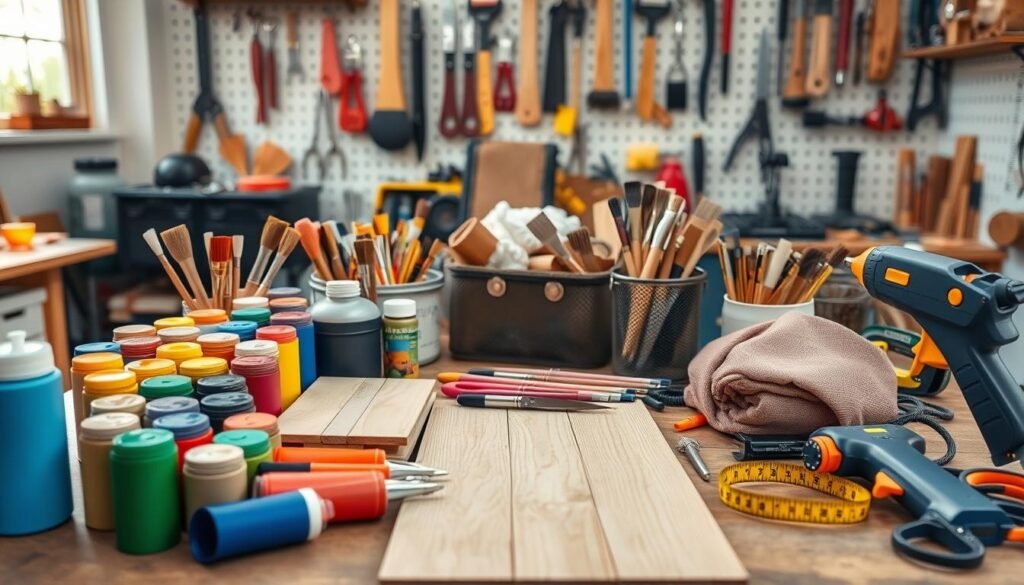
Basic Hardware Tools Every DIYer Needs
Starting a DIY project is exciting and rewarding. But, having the right tools is key. This section covers the essential tools for any DIYer, from power tools to hand tools and safety gear.
Power Tools Essentials
For DIYers, some power tools are must-haves. A cordless drill is great for drilling holes and driving screws. A circular saw is perfect for cutting wood accurately. A jigsaw is great for more complex shapes and patterns.
Hand Tools Must-Haves
- Hammer: A classic tool for driving nails, removing them, and general construction work.
- Screwdrivers: Both flat-head and Phillips-head screwdrivers are essential for assembling and disassembling projects.
- Pliers: Needle-nose pliers, for gripping and bending small objects, and slip-joint pliers, for holding and turning nuts and bolts.
- Utility knife: A sharp blade for cutting, trimming, and scoring various materials.
Safety Equipment Checklist
When working on DIY projects, safety is crucial. Always wear protective eyewear to protect your eyes from debris and dust. Sturdy work gloves help protect your hands. A respirator mask filters out harmful particles during sanding or painting.
| Hardware Tools | Woodworking Equipment | Home Improvement Supplies |
|---|---|---|
| Drill | Circular Saw | Respirator Mask |
| Hammer | Jigsaw | Work Gloves |
| Screwdrivers | Wood Clamps | Protective Eyewear |
With the right tools, you’ll be ready for any DIY project. Always put safety first when working on home improvement or woodworking tasks.
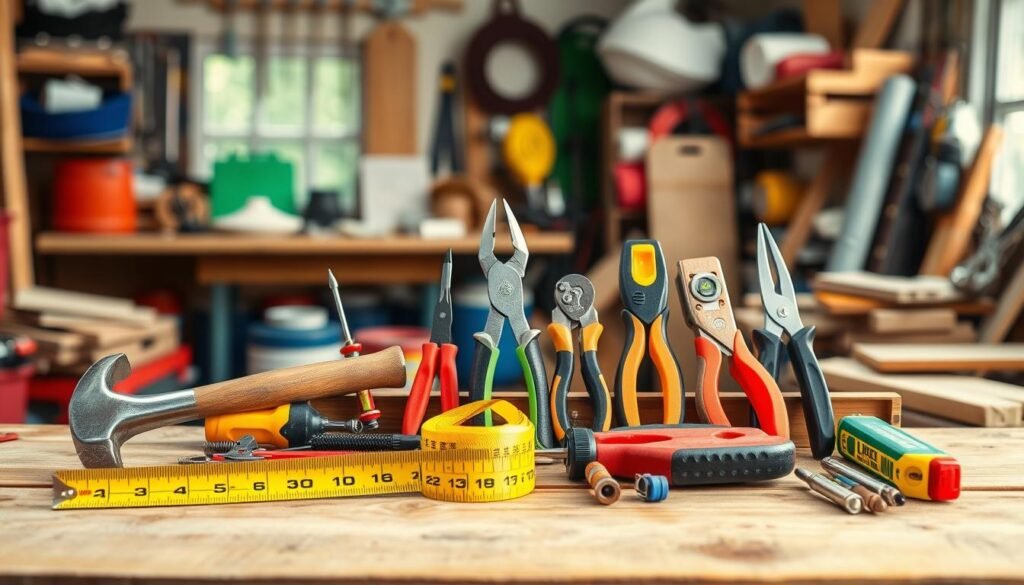
Construction Materials and Building Supplies
For DIY projects, having the right materials is key. You need sturdy lumber and reliable fasteners. These are the basics for any home project. Knowing about construction materials helps a lot.
Lumber is a common material, available in many types and sizes. Softwoods like pine are good for framing. Hardwoods like oak are better for looks or strength. Drywall is great for walls and ceilings, making them smooth for painting.
Concrete is crucial for many projects, from foundations to decorations. You also need masonry supplies like bricks and mortar for walls. Fasteners like nails keep everything in place.
| Construction Material | Common Uses | Key Considerations |
|---|---|---|
| Lumber | Framing, cabinetry, furniture | Species, grade, and dimensions |
| Drywall | Wall and ceiling finishing | Thickness, fire-resistance, and moisture-resistance |
| Concrete | Foundations, patios, and decorative elements | Strength, curing time, and admixtures |
| Masonry Supplies | Walls, chimneys, and landscaping | Size, texture, and mortar requirements |
| Fasteners | Securing materials together | Type, size, and intended use |
Knowing about common materials is vital for DIY projects. It helps your project last and meet your needs.

“The quality of the materials used in a construction project can make or break its success.”
Creative Craft Supplies for Artistic Projects
Start your creative journey with a wide range of craft supplies and art materials. This section is for both seasoned DIYers and beginners. It will show you the essential tools and supplies to make your ideas come to life.
Paper Crafting Materials
Explore the world of paper crafting. You’ll find everything from colorful cardstock and scrapbooking papers to origami sheets and calligraphy tools. Add unique touches with washi tape, stencils, and die-cut shapes.
Textile and Fabric Supplies
Sewing and textile crafts let you express your creativity in a hands-on way. Check out a variety of fabric supplies, including soft sewing notions, bright threads, and art supplies like fabric paints. Use these materials to create your own fashion or home decor.
Paint and Finishing Materials
Make your artistic dreams real with paints and finishing materials. You can use acrylic, watercolor paints, markers, and colored pencils. Add a special touch with mediums, varnishes, and sealants to keep your work looking great.

Enjoy crafting and let your creativity run wild with these craft supplies and art materials. Whether you’re making detailed paper designs, sewing beautiful textiles, or painting stunning art, the right tools and supplies are key to your success.
Woodworking Equipment and Materials Guide
Starting a DIY woodworking project? Get to know the key woodworking equipment and construction materials needed. This guide will help you with the hardware tools every woodworker needs, no matter their skill level.
Power Tools for Woodworking
These tools will help you achieve amazing results in your woodworking:
- Circular Saws: Great for straight cuts in wood panels and boards
- Jigsaws: Perfect for intricate, curved cuts
- Routers: Essential for decorative edges, grooves, and designs
- Drills: Needed for drilling holes and driving screws
- Sanders: Use them to smooth surfaces and prepare wood for finishing
Essential Hand Tools for Woodworkers
Hand tools are just as important as power tools:
- Measuring Tapes and Rules: For accurate measurements and marks
- Chisels: Useful for shaping, trimming, and removing wood
- Hammers: Great for driving nails and shaping wood
- Handsaws: Ideal for precise cuts and detailed joinery
- Clamps: Hold pieces together during assembly
| Woodworking Material | Description | Common Uses |
|---|---|---|
| Hardwood | Dense, durable wood from deciduous trees | Furniture, cabinetry, flooring |
| Softwood | Less dense wood from coniferous trees | Framing, fencing, outdoor projects |
| Plywood | Engineered wood made from thin wood veneers | Cabinetry, shelving, tabletops |
| Medium Density Fiberboard (MDF) | Engineered wood made from wood fibers | Furniture, shelving, moldings |
With the right woodworking equipment and construction materials, your DIY projects will look professional. Dive into woodworking and let your creativity flow.
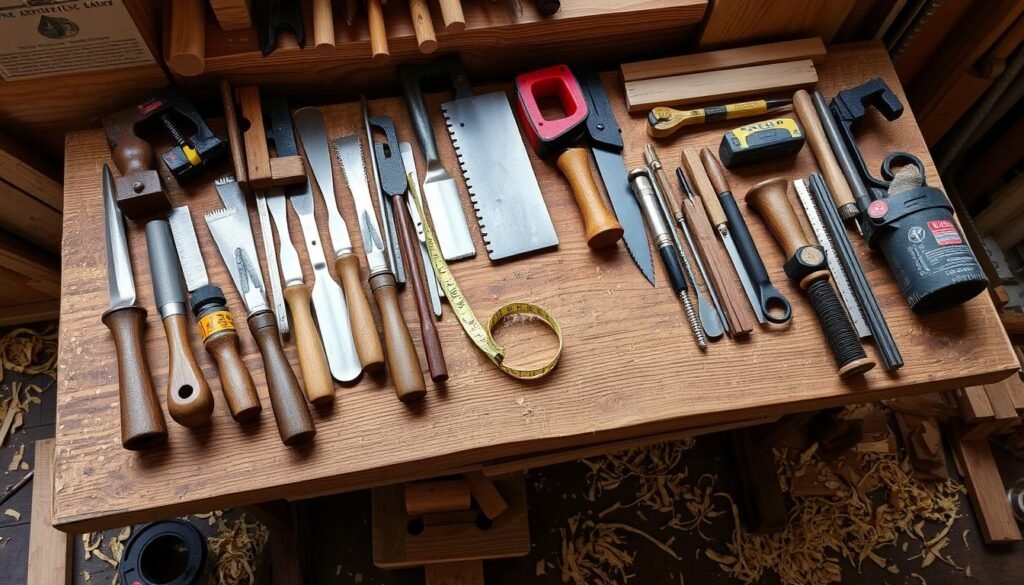
Sustainable and Recycled Materials for Eco-Friendly Projects
DIY projects are now focusing more on sustainable and recycled materials. Using recycled materials in your projects helps reduce waste. It also supports a greener future. Let’s dive into upcycling and eco-friendly considerations for your next project.
Upcycling Material Sources
Finding the right materials is key for sustainable projects. Check out local thrift stores, secondhand shops, or online platforms for recycled materials. You can find everything from reclaimed wood to vintage fabric scraps. These items can make your home improvement supplies and gardening tools truly unique.
Environmental Impact Considerations
Choosing materials for eco-friendly projects requires thought. Opt for biodegradable, non-toxic, and low-carbon materials. Consider bamboo, hemp, or cork, and recycled plastics or metals. Making smart choices helps reduce environmental harm and supports a sustainable future.
| Sustainable Material | Environmental Benefits | Potential DIY Applications |
|---|---|---|
| Bamboo | Rapidly renewable, biodegradable | Furniture, flooring, home decor |
| Recycled Plastic | Reduces waste, conserves resources | Outdoor furniture, garden beds, containers |
| Cork | Biodegradable, renewable | Bulletin boards, coasters, wall art |
Using recycled materials and thinking about their environmental impact makes your DIY projects better. They look great and help the planet. Get creative and make a difference with your next project!

Storage Solutions for Project Materials
Organizing your DIY project materials can make a big difference. It keeps your workspace tidy and makes it easy to find what you need. Start by picking out storage containers, shelves, or cabinets for your tools and materials. Make sure to label everything so you don’t get confused.
Consider using pegboards to hang tools you use often. Plastic bins or clear containers are great for small items like screws and nails. For bigger items, like wood planks or fabric rolls, get sturdy shelving units or racks.
It’s important to check your storage solutions often and make changes if needed. A well-organized workspace boosts your efficiency and keeps you motivated. With the right storage, you can easily switch between different projects.

Hello, I’m Jane, founder of Home Vibe Ideas. I’m here to inspire stylish Home Design, modern Smart Living, beautiful Outdoor Spaces, and creative DIY Projects to help you create a home that’s uniquely yours.
Disclosure: This post contains affiliate links. If you click on a link and make a purchase, we may earn a small commission at no additional cost to you. The content on this site was created with the help of AI technology.
